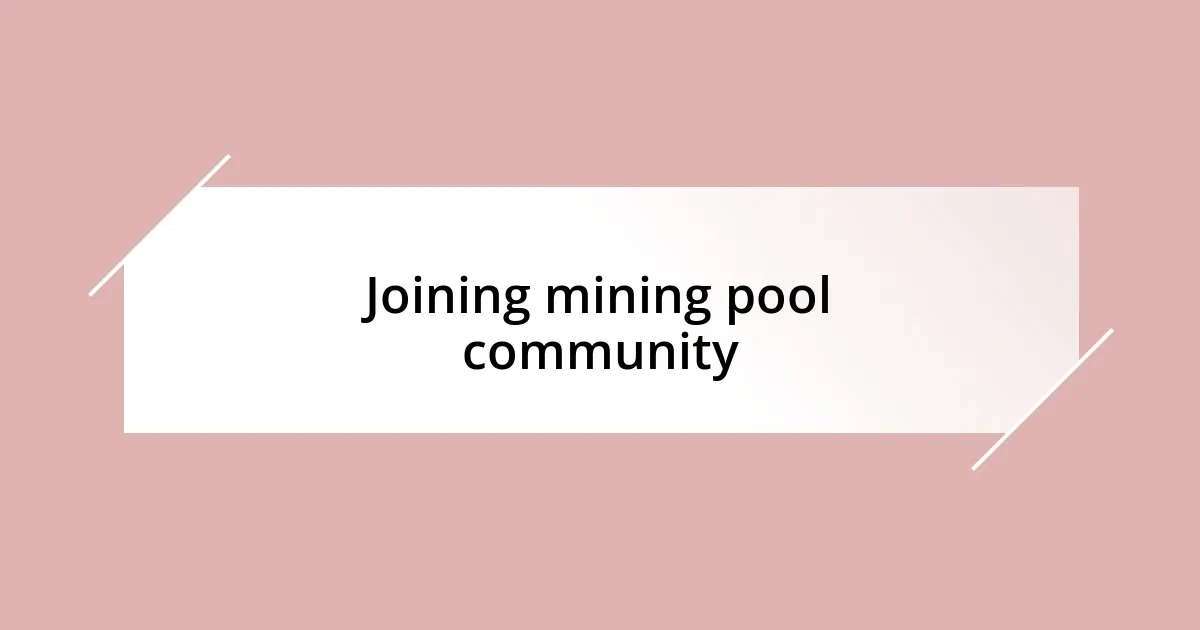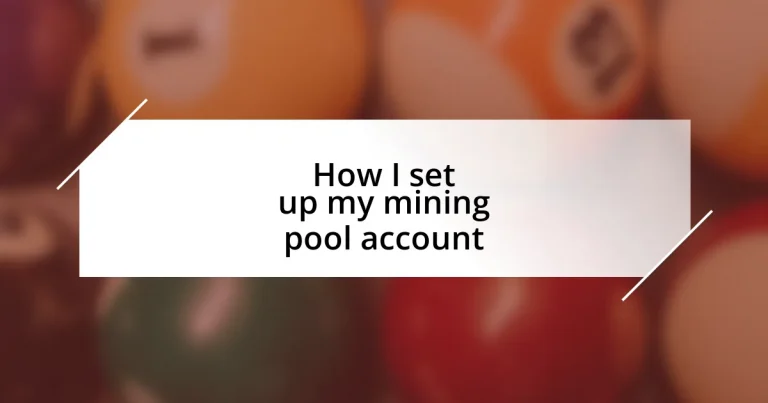Key takeaways:
- Mining pools allow miners to combine computational power, increasing chances of rewards through a shared system.
- Key factors for choosing a mining pool include fee structure, payout methods, pool size, and reputation.
- Setting up wallet preferences and miner settings is crucial for secure transactions and optimal mining performance.
- Joining a mining pool community enhances support, collaboration, and knowledge sharing among miners.

Understanding mining pools
When I first learned about mining pools, I was intrigued by how they function as a collaborative network. Instead of competing solo, miners combine their computational power to increase their chances of earning rewards. It’s like joining forces with fellow enthusiasts, creating a community where knowledge and resources are shared.
One of the most striking aspects of mining pools is the shared reward system. Everyone contributes their hashing power, and when a block is found, the reward is distributed among all participants based on their contribution. I remember the excitement I felt when I received my first payout, a small but significant reward for being part of something bigger. It made me realize that success in the crypto world often lies in teamwork rather than going it alone.
Many beginners might wonder, “Is a mining pool really worth it?” From my experience, pooling offers a steadier income stream compared to solo mining, which can be inconsistent and daunting. This collective approach not only boosts individual earnings but also fosters camaraderie among miners—something I didn’t fully appreciate until I interacted with my fellow pool members and exchanged tips and strategies.

Choosing a mining pool
When it comes to choosing a mining pool, several factors come into play that can significantly impact your mining experience. I remember feeling overwhelmed the first time I looked at the different options. I’d advise others to evaluate the pool’s transparency, reputation, and payment structure—do they have good reviews? Are they consistent with their payouts? These considerations can set the foundation for a fruitful mining journey.
Here are some key points to consider when selecting a mining pool:
- Fee Structure: Look at the fees the pool charges. Some have a percentage fee taken from your rewards, while others might charge a flat rate.
- Payout Method: Pools offer various payout methods like Pay-Per-Share (PPS) or Pay-Per-Last-N-Shares (PPLNS). Research which model aligns with your earnings goals.
- Pool Size: A larger pool might yield more frequent payouts, while a smaller pool could mean less competition.
- Reputation and Longevity: Check community forums and user reviews to confirm the pool’s reliability and track record.
- Support and Communication: Good communication can make a huge difference. I remember choosing a pool that had active support channels, which offered me a great sense of reassurance as a newbie.
By keeping these factors in mind, your choice of a mining pool can lead to more rewarding experiences, making the mining process not just profitable but enjoyable too.

Registering for an account
Registering for an account is the first step toward joining a mining pool. I recall my registration process—it felt both exciting and a bit nerve-wracking. Typically, you’ll need to provide your email address and create a secure password. It’s crucial to choose a password that balances complexity and memorability; I often use phrases that mean something to me.
After entering your details, you usually receive a verification email. I remember waiting for that email, filled with anticipation. Clicking that link confirmed my account and revealed the next steps. Some platforms might ask for additional information, like wallet addresses for payouts. It’s essential to ensure your wallet is compatible with the pool’s payment method—you wouldn’t want your hard-earned rewards to go astray.
While the registration process is generally straightforward, each pool can differ slightly. Below is a comparison of aspects to consider when registering for an account across different mining pools.
| Mining Pool | Registration Process |
|---|---|
| Pool A | Email and password only, with a quick verification email. |
| Pool B | Additional identity verification required, like wallet address and security questions. |
| Pool C | Simple email registration, with optional 2-factor authentication for higher security. |
Understanding these differences can help make your registration as smooth as possible, allowing you to dive right into the exciting world of mining pools.

Setting up wallet preferences
Setting up wallet preferences is a crucial aspect of your mining pool experience. Think about it: without the right wallet, where will your hard-earned cryptocurrency go? When I first set my preferences, I spent quite a bit of time researching different wallets and their features. I found that a wallet’s security is paramount, especially when handling assets like cryptocurrency; a reliable wallet gives you peace of mind.
The next step is determining which type of wallet best suits your needs. I recall weighing the options between hot wallets and cold wallets. Hot wallets are convenient for frequent transactions, but I learned the hard way that they can be more susceptible to hacks. On the other hand, cold wallets offer enhanced security by keeping your assets offline. This choice really boils down to how actively you plan to engage with your mined coins—do you see yourself trading regularly, or are you more interested in long-term storage?
Lastly, remember to set up your wallet address correctly within the mining pool’s platform. In my early days, I mistakenly inputted the wrong address, and that taught me a valuable lesson about double-checking everything. Ensuring that your wallet address is accurate will help guarantee that your payouts are directed to the right place. Have you ever received a payment to the wrong wallet? It’s a sinking feeling that can easily be avoided with a little attention. Knowing that your preferences are set correctly offers a sense of control and confidence as you embark on your mining journey.

Configuring miner settings
Configuring your miner settings is like fine-tuning an engine for optimal performance. I remember the first time I dove into this part—it was both fascinating and overwhelming. Finding the right settings can significantly impact your mining efficiency, so I spent some time experimenting with different configurations. The good news is that most mining software provides a default configuration that works relatively well for beginners. However, it wasn’t until I ventured into custom settings that I noticed a boost in my hash rate.
One of the most critical areas to focus on is the mining algorithm. Depending on what cryptocurrency you’re targeting, you’ll need to select the appropriate algorithm, like Ethash for Ethereum or SHA-256 for Bitcoin. I vividly recall that moment when I realized I had selected the wrong algorithm, which led to hours of frustration and wasted potential. Ensuring that you choose the right one can prevent headaches down the line. Also, consider adjusting the intensity level; tweaking this can sometimes mean the difference between steady returns and a mining setup that feels sluggish.
Additionally, monitoring your hardware temperature is essential. I can’t stress enough how crucial it is to keep an eye on those stats; I learned the hard way when my rig overheated and caused temporary damage. Most mining programs have built-in tools to track temperatures—take advantage of them! Setting up automatic shutdown thresholds gives you peace of mind, ensuring that your investment is safeguarded while you’re away. Have you set those limits? It’s a simple step that can save you a significant amount of stress later on.

Joining mining pool community
Joining a mining pool community opens up a world of support and collaboration. When I first started, I felt a bit lost, but becoming part of a pool helped me connect with fellow miners who were eager to share their experiences. It felt reassuring to know I wasn’t alone; having a community to turn to made all the difference during those initial challenges.
Engaging with others in a mining pool allows you to learn best practices and stay updated on trends in the industry. I remember encountering a forum where someone shared tips about optimizing settings based on the current market conditions. This kind of shared knowledge is invaluable, and it fosters an atmosphere where everyone benefits from each other’s successes and failures. Have you ever found a tip that changed the game for you? I certainly have, and it’s moments like these that make being part of a community so rewarding.
Lastly, many pools have communication channels, such as Discord or Telegram, where members chat in real-time. I found great camaraderie in these spaces; sharing both triumphs and frustrations helped build friendships. It’s amazing how a simple chat can lead to discovering someone facing the same hurdles you are, allowing for collective problem-solving. If you’re not engaging with your mining pool community, you might be missing out on a wealth of support and shared insights. Why not dive in?














